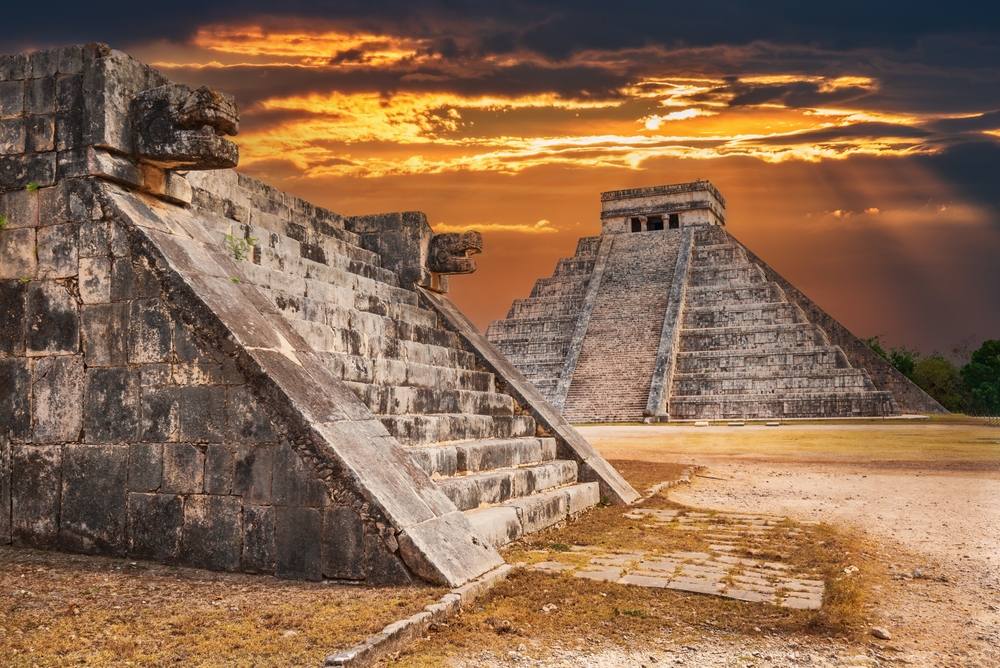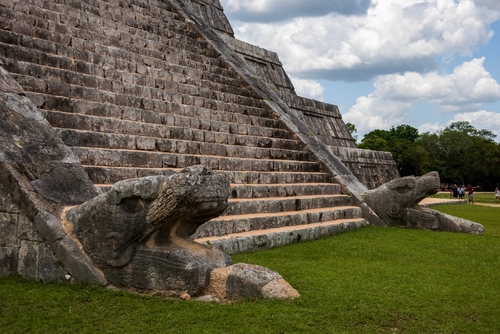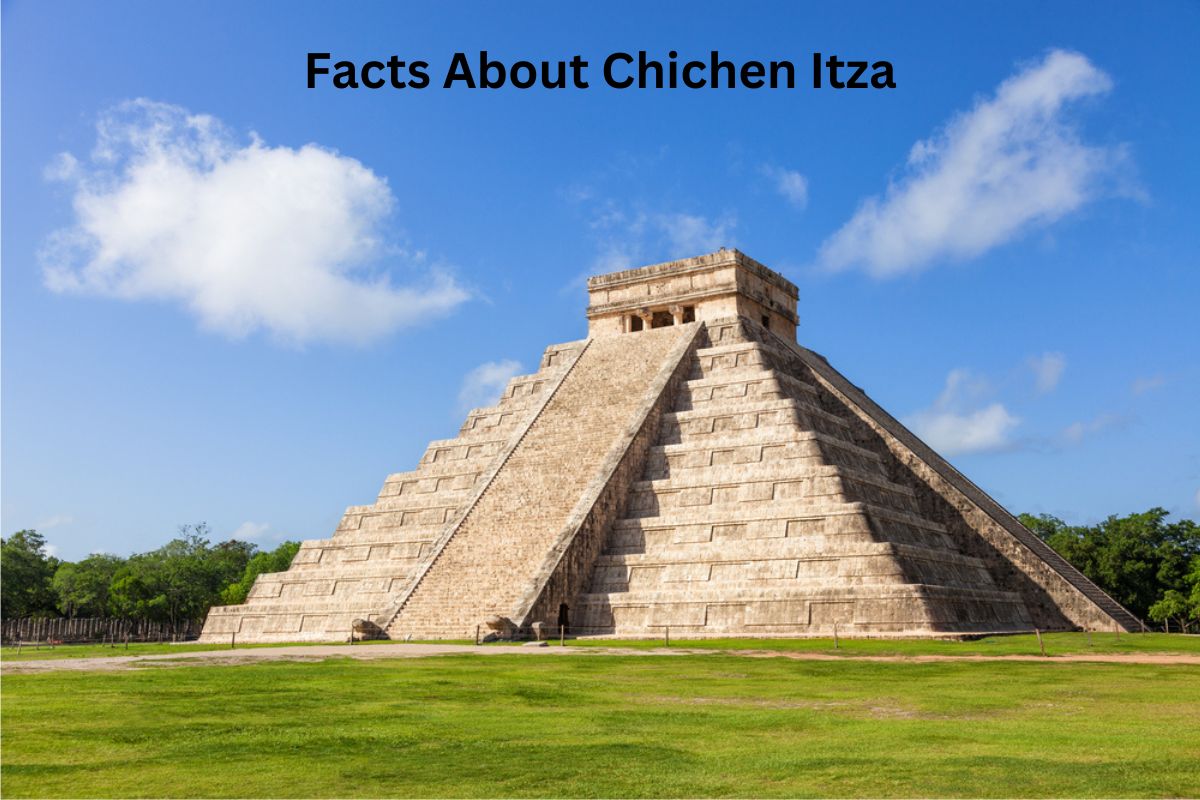Chichen Itza is an ancient archaeological site nestled in the Yucatan Peninsula of Mexico. Once a thriving city of the Maya civilization, it holds a prominent place in history as a UNESCO World Heritage Site.
The site’s iconic structures, such as El Castillo (The Pyramid of Kukulcan) and the Temple of the Warriors, reveal the remarkable architectural and astronomical knowledge of the ancient Maya.
Additionally, Chichen Itza’s cultural significance lies in its role as a center of religious ceremonies, ball games, and the veneration of sacred cenotes.
Although its decline and abandonment remain enigmatic, modern restoration efforts have transformed Chichen Itza into a captivating destination that fascinates tourists and historians alike.
Chichen Itza Facts
1. Ancient Maya city in Mexico
Chichen Itza is an archaeological site located in the eastern part of the Yucatan Peninsula, Mexico. The site covers an area of about 6.5 square kilometers and is situated in the present-day state of Yucatan.
Also Read: Mayan Pyramids Facts
The name “Chichen Itza” is derived from the Mayan language and translates to “At the mouth of the well of the Itza,” referring to the cenote (sinkhole) located within the site.
2. UNESCO World Heritage Site
Chichen Itza’s historical and cultural significance led to its designation as a UNESCO World Heritage Site in 1988.
Also Read: Facts About Teotihuacan
This recognition highlights its importance as a well-preserved example of the ancient Maya civilization and its contributions to human history and culture. The site’s inclusion on the list aims to protect and preserve its archaeological treasures for future generations.

3. El Castillo (The Pyramid of Kukulcan) is a famous step-pyramid
El Castillo is perhaps the most recognizable and iconic structure at Chichen Itza. Also known as the Pyramid of Kukulcan, it is a massive step-pyramid that stands approximately 30 meters (98 feet) tall.
The pyramid has a square base, and each side has a staircase with 91 steps, totaling 364 steps in all four sides. Including the top platform as the final step, it makes 365 steps, symbolizing the number of days in the solar year.
4. Equinox phenomenon creates a snake-like shadow on El Castillo
The construction of El Castillo is a testament to the advanced engineering and architectural skills of the ancient Maya.
It was built in a way that aligns with astronomical events, and during the spring and autumn equinoxes, a fascinating optical illusion occurs. As the sun sets, shadows form along the corners of the pyramid, creating the appearance of a serpent descending the steps.
This phenomenon is often referred to as the “serpent effect” and is believed to symbolize the descending of the feathered serpent god Kukulcan or Quetzalcoatl, a deity revered by the Maya and other Mesoamerican cultures.
El Castillo served as a ceremonial temple, and religious rituals, including offerings and astronomical observations, were performed at the top platform. The temple’s orientation and architectural features indicate a strong connection to the Maya’s astronomical knowledge and their reverence for celestial events.
The pyramid’s significance as a religious and astronomical center reinforces the idea that Chichen Itza was not only a political and economic hub but also a site of profound cultural and spiritual importance for the ancient Maya civilization.
5. Largest and best-preserved ball game court in Mesoamerica
Chichen Itza is home to the largest and most well-preserved ball game court in Mesoamerica, a region that includes present-day Mexico and parts of Central America.
The ball game, known as “Pitz” in the Mayan language, held great cultural and religious significance among the ancient Maya. The court consists of two parallel walls with sloping sides, and players used their hips to propel a rubber ball through stone rings attached to the walls.

6. Temple of the Warriors honors military achievements
The Temple of the Warriors is another prominent structure at Chichen Itza. It is a complex consisting of a large stepped pyramid with a temple on top and a vast colonnade of carved columns.
The temple’s name likely comes from the numerous sculptures of warriors found on the pillars. The complex was likely dedicated to a warrior cult or represented the military prowess of Chichen Itza’s rulers.
7. Sacred Cenote is a significant ritual site
The Sacred Cenote, also known as Cenote Sagrado, is a large natural sinkhole located within the Chichen Itza site. Cenotes were vital water sources in the Yucatan Peninsula, and many of them were considered sacred by the Maya. The Sacred Cenote was no exception and held particular religious significance.
It is believed that the cenote was used for various rituals and offerings, including human sacrifices. Archaeological excavations at the site have uncovered numerous artifacts and remains, including precious objects, gold, jade, pottery, and the skeletons of sacrificial victims.
These discoveries suggest that the cenote played a crucial role in religious ceremonies, and offerings were made to appease and honor the gods, particularly the rain god Chaac, to ensure fertility and agricultural prosperity.
8. El Caracol served as an astronomical observatory
El Caracol is an intriguing and unique structure at Chichen Itza. Also known as “The Observatory,” it is a round building with a spiraled staircase inside, resembling a snail’s shell, hence its name. El Caracol is believed to have served as an astronomical observatory for the ancient Maya.
The Maya were skilled astronomers and had an advanced understanding of celestial movements. They closely observed the sun, moon, stars, and planets, using their knowledge to create complex calendars for agricultural and religious purposes.
El Caracol’s architecture allowed them to make precise astronomical observations, track celestial events, and predict solstices, equinoxes, and other important dates. This information would have been crucial for planning agricultural activities, religious ceremonies, and other significant events in their society.
9. Shows strong Toltec influence
Chichen Itza’s history is marked by periods of interaction with other Mesoamerican civilizations, most notably the Toltecs from central Mexico. The Toltecs, known for their military prowess and cultural achievements, had a significant impact on Chichen Itza during its later years, around the 10th century CE.
The Toltec influence is particularly evident in the architecture and art found at Chichen Itza. Examples of Toltec-style structures include the Temple of the Warriors and the Platform of the Eagles and Jaguars, which showcase distinctive design elements reminiscent of the Toltec capital city of Tula.
The integration of Toltec architectural styles at Chichen Itza demonstrates the city’s role as a cultural and political center that connected various regions and civilizations in Mesoamerica.
10. Declined and eventually abandoned for unknown reasons
Chichen Itza’s decline and eventual abandonment are still topics of debate among scholars. It is widely believed that a combination of factors contributed to the city’s decline, leading to its abandonment around the 15th century CE.
One possible factor is environmental degradation. The Yucatan Peninsula faced challenges such as deforestation, soil erosion, and declining agricultural productivity, which could have put strain on Chichen Itza’s resources and population. Additionally, internal conflicts and power struggles among competing factions within the city may have weakened its political stability.
